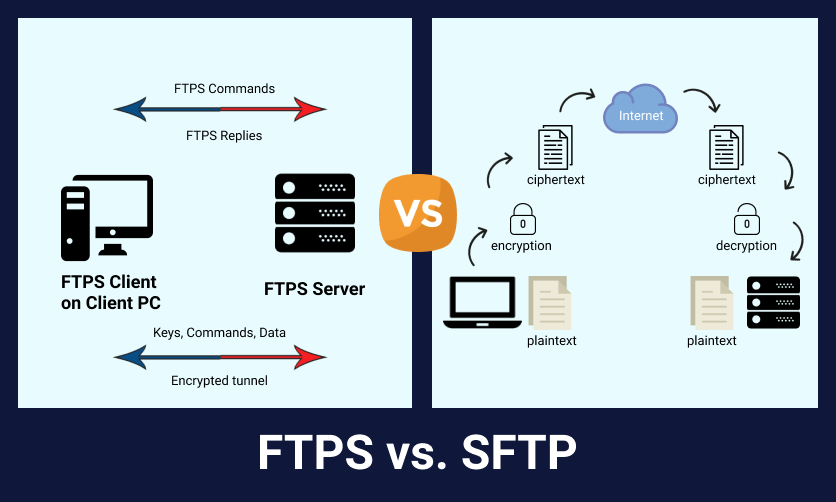Flat-file integrations require employees to download and upload data files between systems manually. This process is time-consuming and can introduce critical errors in your data.
APIs provide a better solution for real-time data exchange, but finding a suitable method for your business takes time and effort.
Authentication
SFTP uses secure SSH (Secure Shell) technology to provide data transfer security. It offers several benefits for businesses, including enhanced authentication, portability, and encryption. SFTP also allows organizations to integrate their file transfer systems into workflows so that content security doesn’t interfere with productivity.
Authentication is essential to SFTP, ensuring only authorized users can access your files. SFTP requires users to upload their public key to the server, and the server uses this to verify user identity when logging in. This method is highly effective at preventing unauthorized access to your data.
Another benefit of SFTP is that it supports a wide range of formats. This makes it easy to transfer large files and folders between platforms. Moreover, SFTP can be used on any platform that supports SSH. It also provides high-level security measures, such as encrypting files and communicating over SSL/TLS connections.
However, SFTP has some drawbacks. First, it requires manual data management, which creates errors and can be time-consuming for employees. Additionally, it only transfers flat files on a scheduled basis, which is inconvenient for companies that need real-time data exchange. This can be a problem when sharing information, such as employee records, which must be updated frequently. In contrast, APIs offer more flexibility and are ideal for dynamic data exchange between systems.
Time-out periods
Companies that want to transfer data between platforms face scalability, security, and speed challenges. In SFTP vs. API integration, SFTP is one solution to these issues, but API integration may be better in certain circumstances. Choosing the suitable method depends on business needs, resources, and technical capabilities.
While SFTP is helpful for bulk file transfers, it could be better for real-time data exchanges. It does not have any inherent way to notify clients of changes in the file system, so it must poll the server periodically and compare a list of files against a previous list. This can be costly and inefficient, especially if the server has many files.
Another issue with SFTP is that it requires a user account to be active on the remote host. This can be a problem for employees on vacation or out of the office for extended periods. This can lead to missed opportunities for businesses and lost revenue.
While APIs are more secure than SFTP, both offer strong security capabilities. The key is ensuring the API architecture is designed with security in mind. This means the API must use SSL or TLS for all communication and allow only trusted IPs to access it. In addition, the API should be configured to use a high-quality SSL certificate to protect data at rest and in transit.
Encryption
SFTP is a protocol used to transfer files. It uses shell encryption to connect two systems and exchange flat files. SFTP can be an excellent option for businesses that need to transfer large amounts of data in bulk and cannot use an API. However, it is unsuitable for real-time data exchange and can be slower than an API.
Another downside of SFTP is that it requires employees to manage sensitive data manually. This can introduce errors and allow crucial issues to perpetuate within the system. It also requires multiple calls and emails with various parties to resolve these problems. Using an API instead of SFTP can eliminate these problems and improve productivity.
Compared to SFTP, APIs offer superior security features. These include machine-readable directory listings, encrypted communication, and user authentication. They are also compatible with many programming languages, and there are graphical and command-line interface clients that make them easier to use. In addition, APIs are designed for real-time data transfer and allow for a more flexible workflow.
When deciding between SFTP and an API, consider your business needs and technical capabilities. SFTP can be more cost-effective than an API for companies that need to transfer data in bulk. But if you need to transfer data regularly, APIs may be more cost-efficient.
File size
The file size measures how much data a computer file contains or how much space it consumes on a storage medium such as an internal/external hard drive, network drive, FTP server, and the cloud. File sizes are typically measured in bytes (B), kilobytes (KB), megabytes (MB), gigabytes (GB), and terabytes (TB). They may also be expressed as decimal or binary based on the prefix used, such as kilo- or tera-.
A flat-file integration method requires employees to download and upload data files between systems manually, resulting in many opportunities for human error. This can allow crucial issues to perpetuate within the systems and wreak havoc on business processes. Moreover, this type of manual integration can be very time-consuming and resource-intensive for teams.
Flat-file integrations do not function in real-time, meaning that the data they receive could theoretically be outdated as soon as it is uploaded. This can cause significant problems for teams who rely on this data, particularly when the data is updated frequently. A modern SFTP solution with webhook notifications can mitigate this issue by promptly ensuring that your custom apps are updated with new data.











